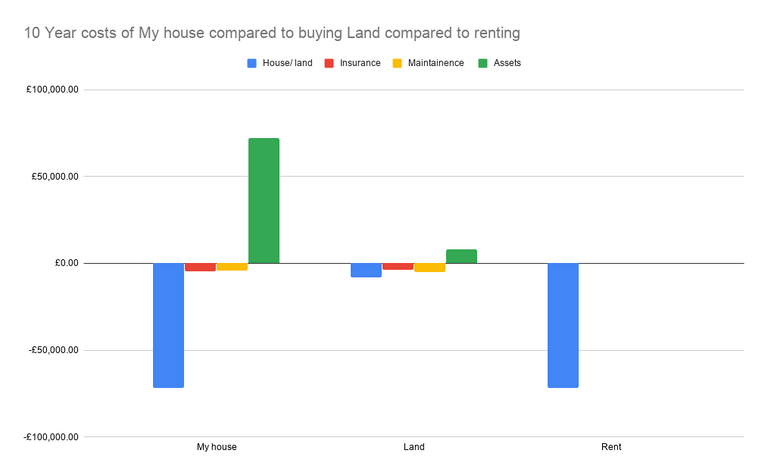The ‘lock-in’ is where a habituated high expenditure lifestyle ties an individual to a 40 year working career and a post-60 retirement age.
This is the norm in the West, but I calculated back in 2014 that an individual on median income could retire by 52, if they made extreme savings related lifestyle changes at age 35, and maintained them for the rest of their life. Here’s a link to the post, (I really must revisit this and do an updated version!)
Given that I know it’s possible to break the lock-in, proof being in the stats, and the fact that I’ve done it myself (I now choose to keep on a mortgage and work part-time), I’m quite keen to hammer-home the extreme-rationality of a ‘saving down’ strategy, rather than what I see as the extremely sub-optimal ‘high expenditure and work ‘til you’re more or less already dead’ norm.
Housing is the main thing which keeps people locked in, and cheap land and temporary dwellings are the most obvious means of breaking the housing-lock in.
Thus owning your own property, be it a regular house (probably via a mortgage) or some Land on which you live off-grid, are sensible strategies to consider if you want financial freedom.
Ironically (?) going deep into debt and taking out a mortgage is an effective path to financial freedom in the long term, at least compared to renting…
Here's my comparison of three possible housing options over 10 years:


The 10 year cost of the dreaded Rental lock-in
If I had been unable to raise a mortgage, it would cost me at least £600 a month to rent out something of a similar quality to my current house.
• £600 times 12 times 10 = £72 000 a year, £600 a month.
• £0 – Maintenance and insurance
• £72 000 = total cost of rent over 10 years, assuming I stay in one place!
• £0 = Property Asset value, but see immediately below.
There is an argument for not owning your own property – you might think you can better invest your initial deposit money elsewhere and receive enough of a return to cover your rent and end up with investments worth more than your house.

The mortgage-path to housing freedom….
This is what I’m currently doing, along with around 65% of other adults in the UK!
• £72 000 - Total cost of the mortgage I took out in 2018 (including interest) to be paid back over 10 years
• £4000 – total cost of buildings and mortgage insurance over 10 years
• £5000 – total cost of maintenance over 10 years.
• £81 000 = total cost of property over 10 years.
• Around £8100 a year total cost, or £700 a month.
• £72 000 = 40% of the asset value of the house in ten years’ time, assuming the value remains the same (the original loan including the interest was around 40% of the 2018 value)
• So that’s about a 90% return on my investment
So after 10 years of paying down the mortgage, I’ve got an asset worth £72 000 and then no rent or debt to pay off, and a place to live in for free (expect maintenance) for the rest of of my life.
NB I did in fact borrow £10K more than I needed, to maintain my other wealth which is still invested, that £10K is what it cost to move house last time I did it!

The extreme low cost, Eco-Village Land alternative
My next big ‘eco-investment’ plan is to take some of that ‘additional wealth’ and buy some land in Portugal – here’s my really optimistic financial overview:
• £8 000 – estimated cost of buying some rustic Land in Portugal
• £5000 – estimated 10-year cost of setting up a small temporary dwelling on the land and maintaining it.
• £3600 – the probable cost of insurance I’d pay over 10 years
• £16 600 = total cost over 10 years
• Around £1660 a year for ‘basic housing costs’, so £150 a month.
• £8 000 = land asset-value assuming the value of land stays the same
• So that’s about a 50% return on my investment.

Final thoughts
This is a thought exercise isolating out basic housing costs and insurance (which is a personal choice in the Eco-vill model above, but a legal requirement to get a mortgage!), done for comparative purposes.
If you can’t afford a mortgage, then the eco-village Land model strikes me as a really effective way of avoiding getting locked-in by high rental costs!
In reality the three housing situations are different (especially 1 and 2 together, which are quite similar, compared to 3), and it would be more accurate a comparison to consider the conflation of other ‘basic needs’ around the two different models – how I’d meet my energy, waste, water, transport needs would be very different, as would tax, and all of these together would yield different results.
However, I wanted to focus on housing to make an analytical point that, financially at least, buying a cheap piece of land abroad, putting up a yurt and living as an eco-homesteader for a decade (or however long) is a really effective way of avoiding paying rent to someone else and paying off their mortgage, or, worse, paying for their daughter's pony.
And if the savings alone don’t convince you, think of the pony: it would probably much rather spend its time just standing around rather than being saddled and ridden around a field by a middle-class brat.
Originally Posted Using LeoFinance